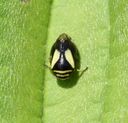Clastopterid Spittlebugs
Clastopteridae
Classification
- Phylum: Arthropoda
- Subphylum: Hexapoda
- Class: Insecta
- Order: Hemiptera
- Suborder: Auchenorrhyncha
- Infraorder: Cicadomorpha
- Superfamily: Cercopoidea
- Family: Clastopteridae
Pronunciation
How to pronounce Clastopteridae: /klæˌstɒptəˈriːdiː/
These audio files are automatically generated. While they are not always 100% accurate, they are a good starting point.
Images






Summary
Clastopteridae are a diverse family of spittlebugs known for their foam-producing nymphs and are found in various habitats across North America, primarily within the genus Clastoptera.
Physical Characteristics
Spittlebugs in the Clastopteridae family typically exhibit a robust body covered in a protective layer of foam or spittle, which they produce as nymphs.
Identification Tips
Identification can be made by observing the forewings; species in Clastoptera often have distinct oblique bands, while other genera may display different markings.
Habitat
Clastopteridae are commonly found in a variety of habitats, including grasslands, meadows, and areas with abundant vegetation where they can feed on host plants.
Distribution
This family is widespread, with over 80 species across three genera recorded in various regions; most species in North America belong to the genus Clastoptera.
Diet
As sap-sucking insects, Clastopteridae primarily feed on the fluid from plant stems, which they extract using their specialized mouthparts.
Life Cycle
The life cycle of Clastopteridae includes egg, nymph, and adult stages. Nymphs are often found in foam, which offers protection from predators and environmental conditions.
Reproduction
Mating behavior in Clastopteridae typically involves the male attracting a female to a suitable location for laying eggs; female lays eggs in plant tissues.
Predators
Natural predators include birds, larger insects, and other arthropods that may feed on nymphs or adults.
Ecosystem Role
Spittlebugs play a role in the plant ecosystem as herbivores and are also prey for various predators, maintaining ecological balance.
Economic Impact
Potential economic impacts are minimal, but they may affect crops by extracting plant sap and facilitating the transmission of plant diseases.
Collecting Methods
- Netting from vegetation
- Using aspirators to collect adults
- Sampling foam nests of nymphs
Preservation Methods
- Ethanol preservation for molecular analysis
- Pinning for adult specimens
- Slide mounting for taxonomic study
Evolution
Preliminary genetic studies indicate divergence within U.S. Clastoptera, suggesting complex evolutionary relationships among species.
Similar Taxa
Misconceptions
Some may confuse spittlebugs with harmful pests; however, they generally do not cause significant damage to healthy plants.
Tags
- spittlebug
- Hemiptera
- Insecta
- plant pests
- Clastoptera